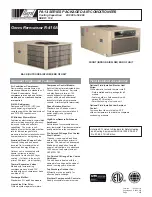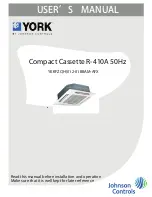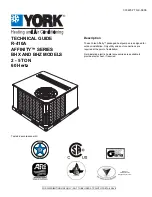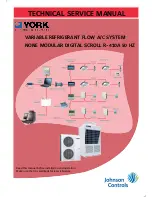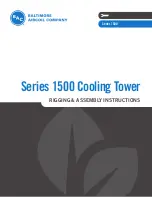
ENGLISH
16
OPERATION TIPS
The following events may occur during normal operation.
1. Protection of the air conditioner.
Compressor
protection
•
The compressor cannot restart for 3 minutes after it stops.
Anti-cold air (Cooling and heating models only)
•
The unit is designed not to blow cold air on HEAT mode, when the indoor heat exchanger is in one of the
following three situations and the set temperature has not been reached.
A) When heating has just starting.
B) Defrosting.
C) Low temperature heating.
•
The indoor or outdoor fan stop running when defrosting (Cooling and heating models only).
Defrosting (Cooling and heating models only)
•
Frost may be generated on the outdoor unit during heat cycle when outdoor temperature is low and humidity
is high resulting in lower heating ef
fi
ciency of the air conditioner.
•
During this condition air conditioner will stop heating operation and start defrosting automatically.
•
The time to defrost may vary from 4 to 10 minutes according to the outdoor temperature and the amount of
frost buildup on the outdoor unit.
2. A white mist coming out from the indoor unit.
•
A white mist may generate due to a large temperature difference between air inlet and air outlet on COOL
mode in an indoor environment that has a high relative humidity.
•
A white mist may generate due to moisture generated from defrosting process when the air conditioner
restarts in HEAT mode operation after defrosting.
3. Low noise of the air conditioner
.
•
You may hear a low hissing sound when the compressor is running or has just stopped running.
This sound is the sound of the refrigerant
fl
owing or coming to a stop.
•
You can also hear a low “squeak” sound when the compressor is running or has just stopped running.
This is caused by heat expansion and cold contraction of the plastic parts in the unit when the temperature
is
changing.
•
A noise may be heard due to louver restoring to its original position when power is
fi
rst turned on.
4. Dust is blown out from the indoor unit.
This is a normal condition when the air conditioner has not been used for a long time or during
fi
rst use of the
unit.
5. A peculiar smell come out from the indoor unit.
This is caused by the indoor unit giving off smells permeated from building material, from furniture, or smoke.
6. The air conditioner turns to FAN only mode from COOL or HEAT (For cooling and heating models only)
mode.
When indoor temperature reaches the temperature setting on air conditioner, the compressor will stop automatically,
and the air conditioner turns to FAN only mode. The compressor will start again when the indoor temperature rises
on COOL mode or falls on HEAT mode (For cooling and heating models only) to the set point.
7.
Dripping water may generate on the surface of the indoor unit when cooling in a high relatively humidity (relative
humidity higher than 80%). Adjust the horizontal louver to the maximum air outlet position and select HIGH fan
speed.
8. Heating mode (For cooling and heating models only)
The air conditioner draws in heat from the outdoor unit and releases it via the indoor unit during heating operation.
When the outdoor temperature falls, heat drawn in by the air conditioner decreases accordingly. At the same time,
heat loading of the air conditioner increases due to larger difference between indoor and outdoor temperature. If a
comfortable temperature cannot be achieved by the air conditioner, we suggest you use a supplementary heating
device.
9. Auto-restart function
Power failure during operation will stop the unit completely.
For the unit without Auto-restart feature, when the power restores, the OPERATION indicator on the indoor unit
starts
fl
ashing. To restart the operation, push the ON/OFF button on the remote controller. For the unit with Auto-
restart feature, when the power restores, the unit restarts automatically with all the previous settings preserved
by the memory function.
10. Lightning or a car wireless telephone operating nearby may cause the unit to malfunction.
Disconnect the unit with power and then re-connect the unit with power again. Push the ON/OFF button on the
remote controller to restart operation.
J287-EN.indd 16
J287-EN.indd 16
07.03.2006 9:30:19 Uhr
07.03.2006 9:30:19 Uhr



















